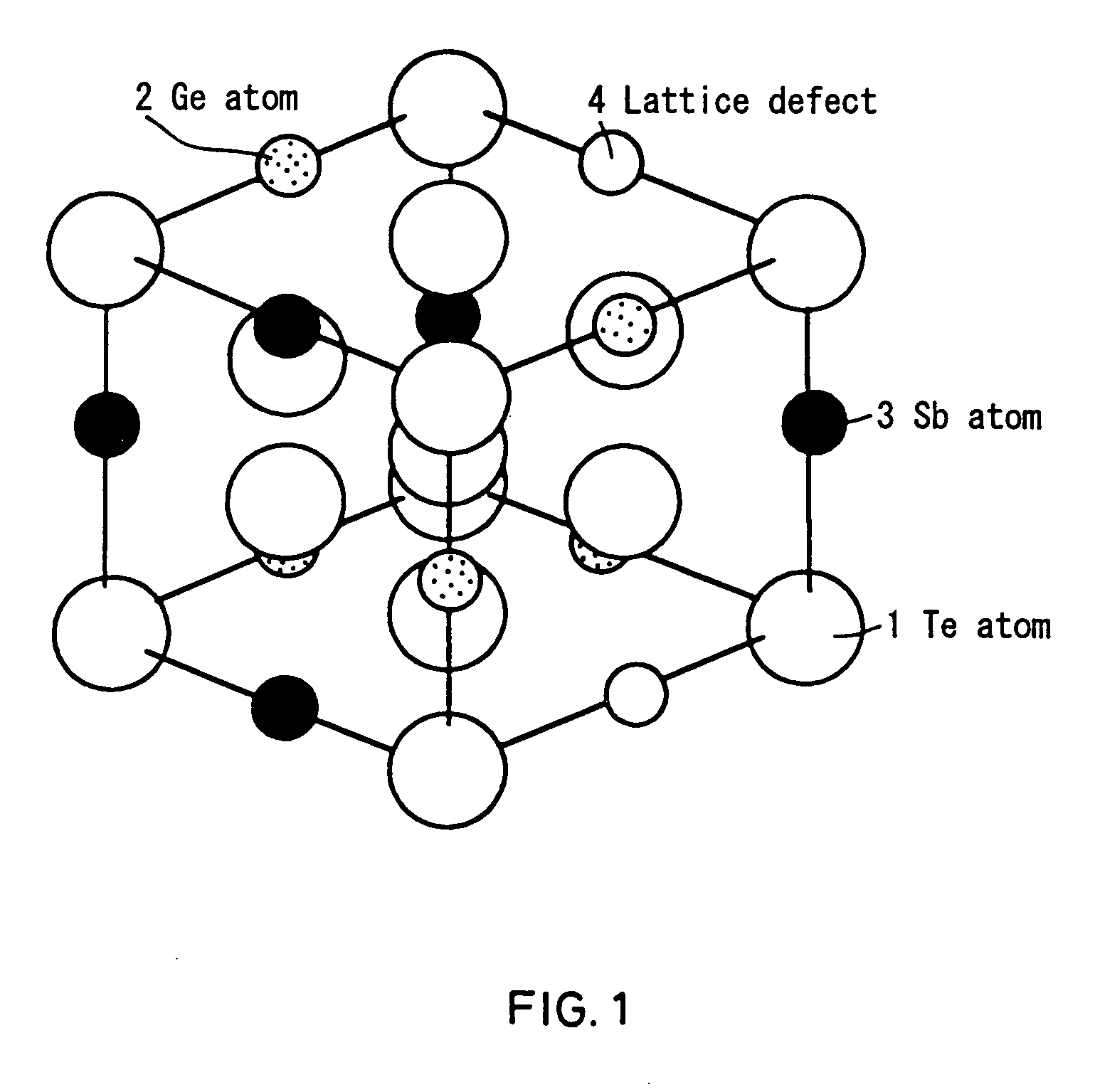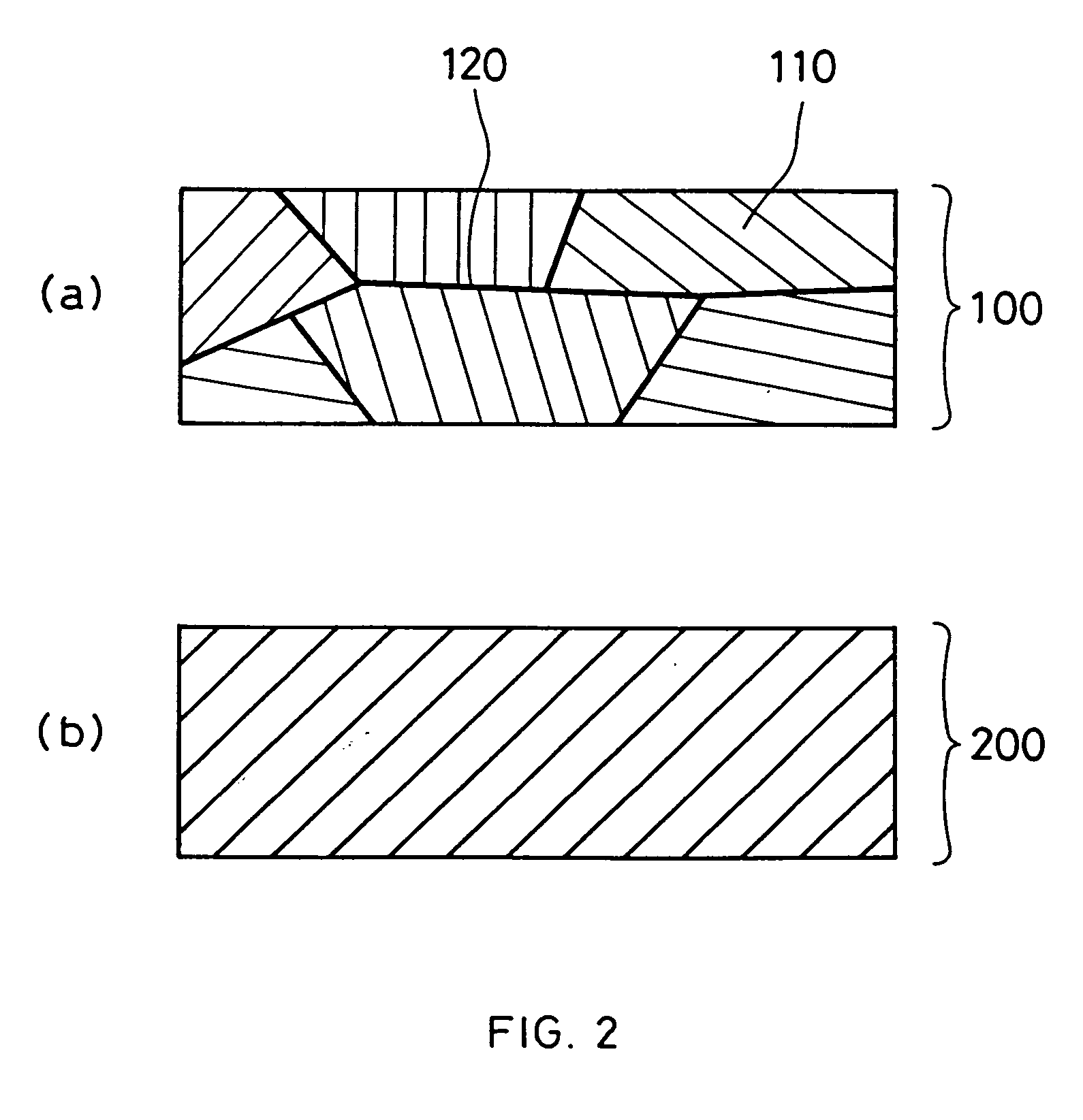Information recording medium and method for manufacturing the same
a technology of information recording medium and manufacturing method, which is applied in the field of information recording medium, can solve the problems of reducing the crystallization speed remarkably, affecting the stability of the amorphous state at room temperature, and affecting the stability of the amorphous state, so as to achieve the effect of less influence, high speed and increased rewriting number
- Summary
- Abstract
- Description
- Claims
- Application Information
AI Technical Summary
Benefits of technology
Problems solved by technology
Method used
Image
Examples
example 1
Example 1 is directed to a method for manufacturing an optical information recording medium according to the present invention. A substrate used in this example was a disc-shape polycarbonate resin substrate that was 0.6 mm in thickness, 120 mm in diameter and 15 mm in inner diameter. A spiral groove was formed substantially on the whole surface of the substrate. The track was a concave-convex groove having a depth of 70 nm. Both the groove portion and the land portion of the track had a width of 0.74 μm. A multilayer film would be formed on the surface later. A laser beam for recording / reproducing an information signal can move to an arbitrary position on the disk by a servo signal provided from the concave-convex shape. On the substrate, the following layers were formed in this order: a ZnS:20 mol % SiO2 protective layer 150 nm in thickness; a Ge2Sb2Te5Al0.5 thin film 20 nm in thickness; a GeN interface layer 5 nm in thickness; a ZnS:20 mol % SiO2 protective layer 40 nm in thickn...
example 2
On a quartz substrate, eight kinds of thin film material were formed by DC sputtering. The materials were represented by Ge2Sb2Te5Alx, in which Al:x=0.0, A2:x=0.2, A3:x=0.5, A4:x=1.0, A5:x=1.5, A6:x=2.0, A7:x=2.5, and A8:x=3.0. The base vacuum degree was 1.33×10−4 Pa, and Ar was introduced to make the vacuum degree to be 1.33×10−1 Pa. Under this condition, 100 W power was applied between a cathode and an alloy target of 100 mmΦ in diameter so as to form a thin film having a thickness of 20 nm. These samples were monitored by using a He—Ne laser beam in the varying strength of the transmitted light while being heated at a programming rate of 50° C. / minute in order to measure a temperature at which transmittance was decreased remarkably as a result of crystallization. The results are shown in Table 3.
TABLE 3Relationship between Al concentration in a Ge2Sb2Te5 thin filmand crystallization temperature · crystallization speedSampleA1A2A3A4A5A6A7A8Al con.1)0%2.2%5.3%10%14.3%18.2%21.7%2...
example 3
Eight optical disks from a1 to a8 were prepared by using the compositions of Example 2 in the method of Example 1. These disk media were rotated at a linear velocity of 9 m / s, and light beams having a wavelength of 660 nm emitted from a laser diode were focused on the disks by using an optical system comprising an object lens having NA of 0.6. At this time, as shown in FIGS. 6A-6C, overwriting recording was carried out in a 8-16 modulation (bit length: 0.3 μm) by applying a multi-pulse waveform corresponding to waveforms of signals ranging from a 3T signal to a 11T signal. The peak power and bias power were determined as follows. First, a power to provide an amplitude of −3 dB to a saturation value of the amplitude was obtained and the power was multiplied by 1.3 to provide a peak power. Next, the peak power was fixed while the bias power was determined to be variable for conducting 3T recording. 11T recording was conducted with the same power for measuring a damping ratio of the 3...
PUM
| Property | Measurement | Unit |
|---|---|---|
| molar ratio | aaaaa | aaaaa |
| radius | aaaaa | aaaaa |
| radius | aaaaa | aaaaa |
Abstract
Description
Claims
Application Information
 Login to View More
Login to View More - R&D
- Intellectual Property
- Life Sciences
- Materials
- Tech Scout
- Unparalleled Data Quality
- Higher Quality Content
- 60% Fewer Hallucinations
Browse by: Latest US Patents, China's latest patents, Technical Efficacy Thesaurus, Application Domain, Technology Topic, Popular Technical Reports.
© 2025 PatSnap. All rights reserved.Legal|Privacy policy|Modern Slavery Act Transparency Statement|Sitemap|About US| Contact US: help@patsnap.com



